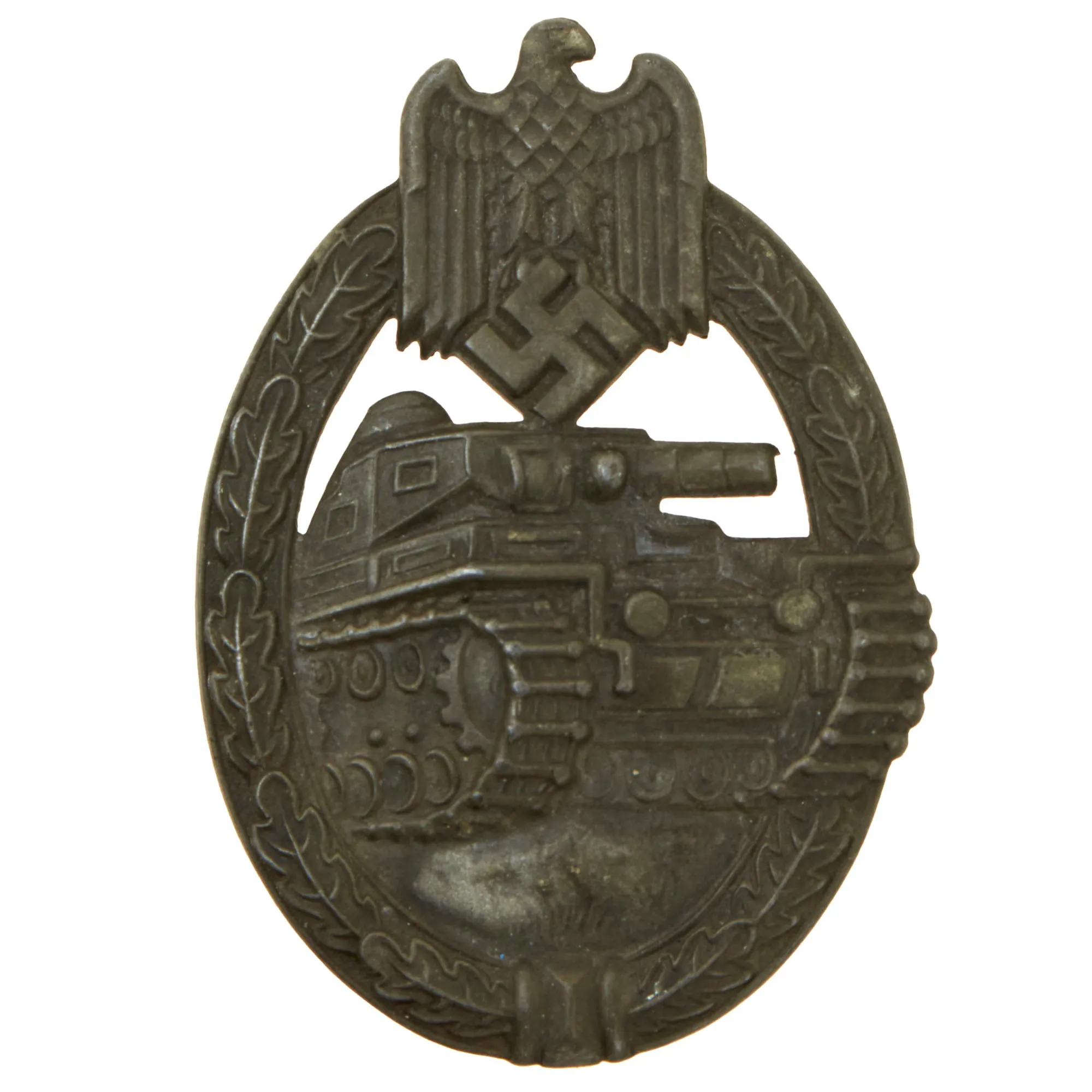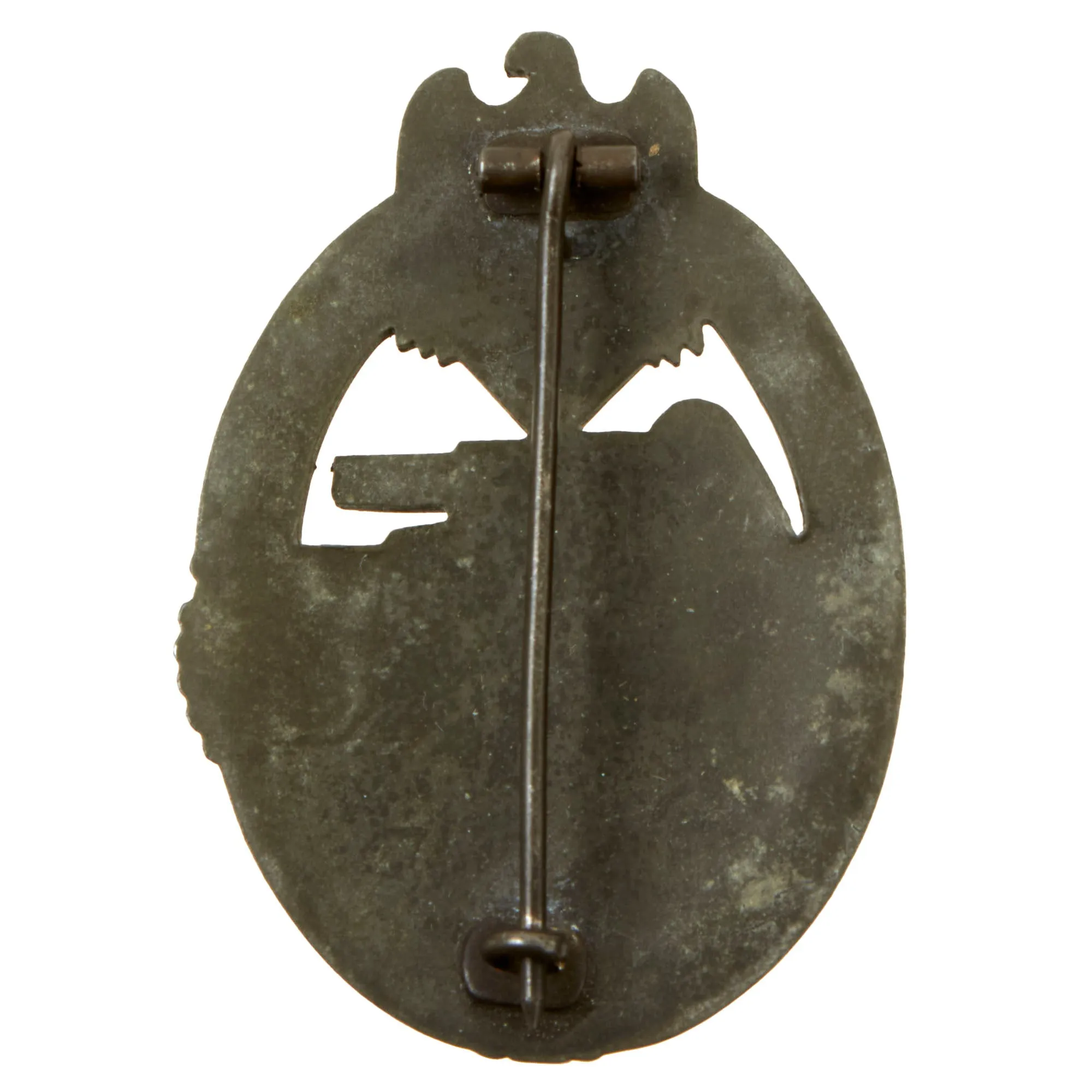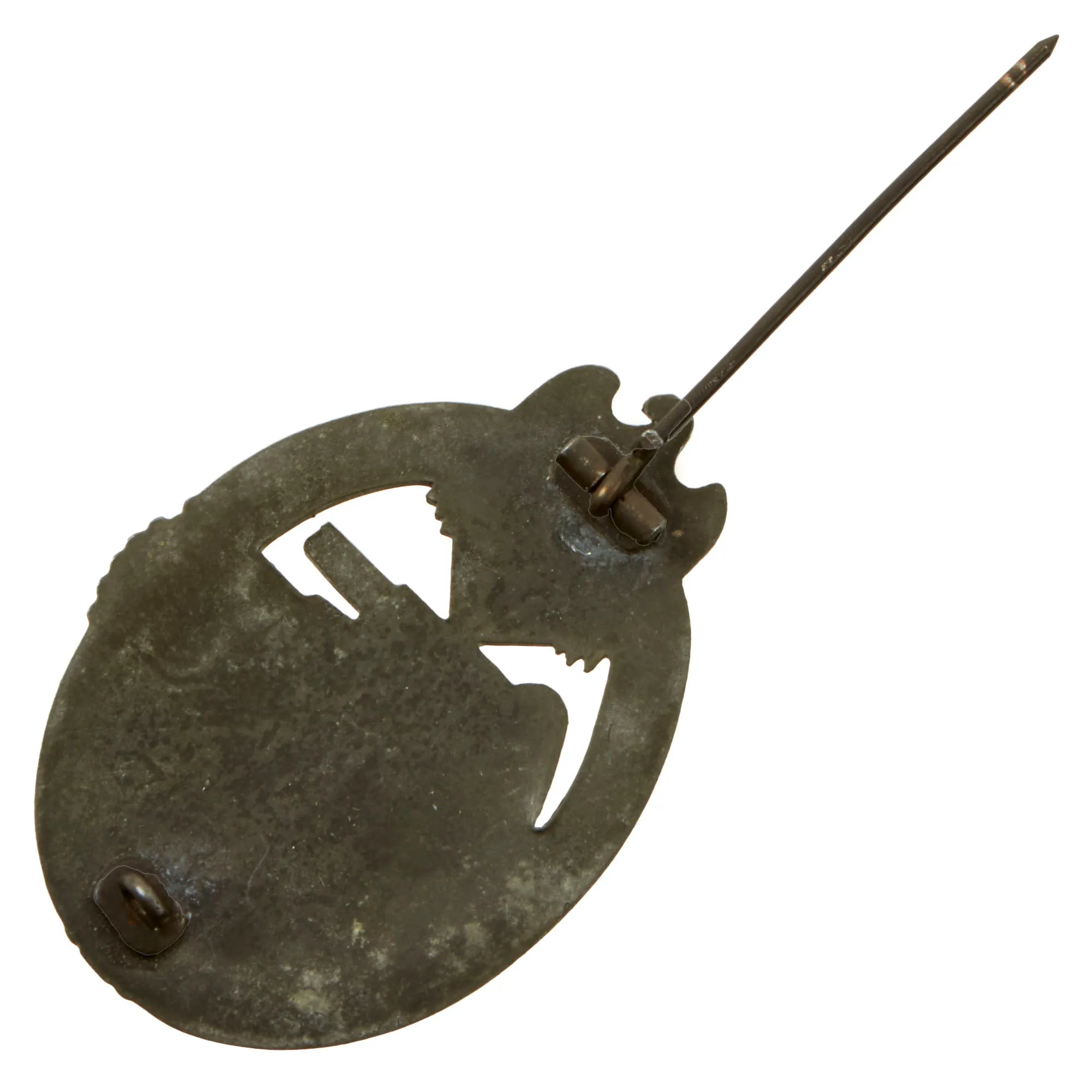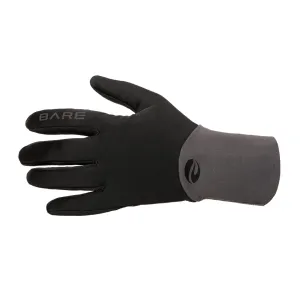Original Items: One-of-a-kind grouping. This is a fantastic named Heer Panzergrenadier award and document set, with two original German WWII awards, each with their original BESITTZZEUGNIS "possession/award" certificates. Both are named to the same soldier, Richard Reusch. The earlier document lists him as a Gefreiten (Exempted), an enlisted rank equivalent to a U.S. Army "Acting" Corporal, while a document dated a year later lists him as a Obergefreiten (Senior exempted), equivalent to a U.S. Army Corporal. This shows his progression over the last years of the war as a senior enlisted man.
The two awards earned by this soldier in date received are the Eisernes Kreuz II. Klasse 1939 (Iron Cross 2nd Class 1939 - EKII) and the Panzer-Kampfabzeichen im Bronze (Panzer Assault Badge in Bronze). Both awards are in very good condition, showing light wear and age, especially the Panzer badge, which has patinated to a very dark color. The EKII has the original ribbon, and really looks great.
The Iron Cross document measures approximately 7.875" x 5.5" (20cm x 14cm), while the Panzer Assault Badge document measures slightly larger at 8.125" x 5.75" (20.7cm x 14.7cm). Both are printed on mid-weight paper with black print and typed in particulars. All of the documents are dated, with their correct stamps and signatures. The EKII document indicates that Reusch was a member of 7. / Schtz. Rgt. 66, or 7th Company, Schützen Regiment 66, while the Panzer Badge document has him in 7. / Pz. Gren. Rgt. 66, or 7th Company, Panzergrenadier Regiment 66. These are in fact the same unit.
Panzergrenadier regiments were motorized / mechanized infantry troops, and were legendary in the field. Originally called Schützen regiments, they had used the same Pink piping as the Panzer corps. Then in 1942 Infantry Regiments were renamed as Grenadier Regiments by Adolf H as a historical homage to Frederick the Great's Army, and the Schützen were renamed to Panzergrenadiers.
The first document indicates that the Iron Cross 2nd Class was awarded to Reusch on 6. Nov. 1941, when he held the rank of Gefreiten. The location is given as Hf. Morsko-Tschulekskije, which looks to be a location in Poland. This document also bears the stamp of the 13. Panzer-Division, and was signed by Generalmajor und Div.Kdr. Düvert, for Walter Düvert. He commanded the 13th Panzer Division 14 June 1941 – 28 November 1941, during which time he was awarded the Knight's Cross of the Iron Cross, on 30 July 1941. It's very rare to have a period document signed by a Knight's cross recipient.
The second document indicates that the Panzer Assault Badge in Bronze was awarded to Reusch by the Regimental Enlisted Staff on 21. 11. 1942, when he held the rank of Obergefreiten. The document bears the stamp of the Schütz. Rgt. 66, and is signed by an Oberstleutnant u. Rgt. Führer.
Both award documents are in good condition, with the expected wear and yellowing from age. They all show folding and very light staining, as expected of documents of this age. Please consult the pictures for condition specifics.
In addition to the award documents, there are also two additional documents from after V-E day. The first is a Bescheinigung (certificate) named to Obgefr. Richard Reusch, born 1. 8. 21., which gives a list of the awards he has received, and is 13. Juni 1945. This has a "sanitized" regimental stamp from the Pz. Gren. Ers. Btl. 66, which Reusch was assigned to at the very end of the war.
The other document is a post war document in German and English, dated 22. Juli 1945, which looks to be his U.S. occupation military discharge papers. There are additional stamps and dates on the reverse, with one from 30. 8. 45. We rarely have had occupation era documents, and this represents a fantastic chance for further research.
A really nice German WWII award and document set, complete with additional documents, named to the same soldier who was a member of the same unit for a long time. Ready to research and display!
There is no more iconic German military award than the Iron Cross (Eisernes Kreuz, abbreviated EK). The long history of this order began during the Napoleonic Wars. It was established by King Friedrich Wilhelm III of Prussia in March 1813, backdated to the birthday of his late wife Queen Louise on 10 March 1813 (EK 1813), who was the first person to receive this decoration (posthumous). The award criteria changed somewhat with time, but generally speaking, Iron Crosses could be awarded for individual acts of bravery, or for leadership achievements on the battlefield. The design was created by a Karl Friedrich Schinkel, his choice of the black cross with silver outline was derived from the heraldic emblem of the Teutonic Knights.
There were a number of different type and grades of Iron Cross awards throughout its long history, but the basic details of the most widely awarded grades: The Iron Cross 1st Class and Iron Cross 2nd Class- remained the same. The first class award was a breast badge, with fittings on the reverse to allow it to be worn on the uniform. These fittings varied widely over time and from maker to maker, and could be a simple in and catch, a screw post and retaining disc, or more elaborate setups. The second class award was suspended from a ribbon, originally in the Prussian colors of black and white, later in the Reich colors of black, red and white.
On the original versions of these crosses, in 1813, the front of the iron core of each grade was bare, and only the second class award had ornamentation: a crown over the initials “FW” representing the King, a sprig of oak leaves, and the date 1813. The core was redesigned in 1870, when the cross was re-instituted during the Franco-Prussian War. The reverse ornamentation on the Iron Cross 2nd Class remained the same, but the front of the core on both grades now bore another crown, a “W” representing Kaiser Wilhelm, and the date 1870. This pattern repeated again when the cross was reinstituted for WWI- everything stayed the same, only the date 1870 was replaced with 1914.
The final reinstitution of the cross came in 1939. For this version, the front of the core for both grades bore a swas and the date 1939. The oak leaves, crown and royal initials were removed from the reverse, with only the date 1813 remaining as a reminder of the legacy of this award. In WWII, hundreds of thousands of Iron Cross First Class awards were bestowed, and four and a half million Iron Cross Second Class awards. Iron Crosses were made by a large number of authorized manufacturers. Some variants of these awards were mass produced in huge numbers. Others were made in very limited quantities.
The Iron Cross was normally a military decoration only, though there were instances of it being awarded to civilians for performing military functions. Two examples of this were civilian test pilots Hanna Reitsch who was awarded the Iron Cross 2nd Class and 1st Class and Melitta Schenk Gräfin von Stauffenberg, who was awarded the Iron Cross 2nd Class, for their actions as pilots during World War II.
The Panzer Assault Badge (Panzerkampfabzeichen) was a World War II German military decoration awarded to troops in armored divisions. The Panzer Badge was introduced on 20 December 1939, in order to recognize the achievements of Panzer personnel who took part in armored assaults. It was designed by the Berlin firm of Wilhelm Ernst Peekhaus, and was instituted by order of Generaloberst Walther von Brauchitsch. On 6 June 1940, a separate class of the badge, in Bronze, was added in order to recognize the crews of armored vehicles other than tanks. The award document that came with it was the common type that had the particulars of the recipient (rank, name) and the authorizing signature of an officer. The Panzer Badge was worn on the left tunic pocket.
The bronze version of the Panzer Badge was authorized for armored personnel and Panzer grenadier units equipped with armored vehicles. It was also to be presented to members of armored reconnaissance groups and rifle battalions of Panzer divisions. The authorization of these badges was usually done at a regimental or divisional level.


























